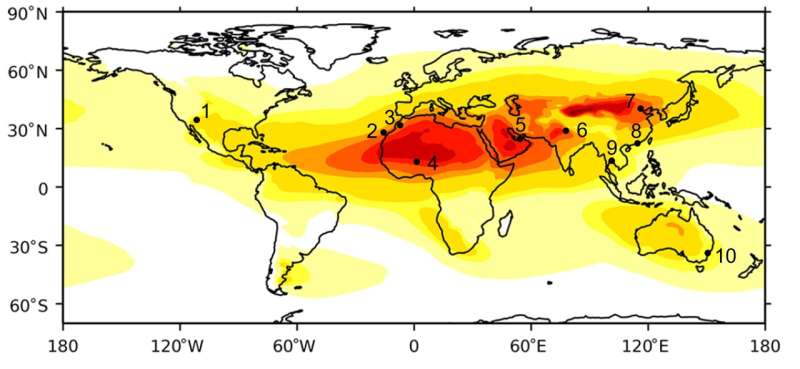This article has been reviewed according to Science X's editorial process and policies. Editors have highlighted the following attributes while ensuring the content's credibility:
fact-checked
trusted source
proofread
Scientists link engine wear to dust ingestion at major airports

Planes flying into one of the world's busiest airports are ingesting around 10kg of dust per 1,000 flights—with most of this dust ingested while they are waiting to land, new research has revealed.
Scientists used 17 years of ECMWF atmospheric data and data from the CALIPSO satellite to calculate the quantity of sand and dust swallowed by jet engines at ten major international airports located in desert regions or subject to seasonal dust storms.
The global study, published in the journal Natural Hazards and Earth System Sciences, found that the largest dust doses were ingested at airports close to the Sahara desert, the Middle East and Northern India, when dry and hot conditions drive large dust storms. Summer flights into Delhi topped the list, ingesting an average of 6.6g per arrival in the run up to monsoon season, and 4.4 grams upon departure.
Delhi is followed by Dubai and Niamey, Niger at 4.3g and 4.7g per arrival respectively, while flights into Beijing swallowed 2.9g on average.
Dr. Claire Ryder, from the University of Reading and lead author of the study, said, "Dust and sand are dangerous to aircraft because dust melts to form glassy deposits on blades or hard mineral crusts inside engines. These crusts disrupt airflow and cause overheating, resulting in accelerated engine wear.
"Although the amount of dust ingested per flight is not huge, the amounts quickly add up. A plane consuming five grams of dust per arrival and departure will eat 10kg of dust over 1,000 flights. Planes will consume more dust when they are at lower altitudes waiting to land, though this depends on the local weather conditions which affect the height of a dust plume in the atmosphere.
"Climate change may lead to a dustier world as temperatures rise and deserts expand, but we cannot say for sure—yet. Climate models do not currently provide a consensus on whether global warming will mean a dustier world, as dust emissions depend on a lot of factors, such as soil moisture, precipitation, surface wind patterns and vegetation cover.
"Ongoing research at the University of Reading is working to improve the ability of climate models to predict dust emissions and transport through the atmosphere."
Holding patterns
The research team found that aircraft ingest more dust while they are performing holding patterns (which is the formation aircraft assume while pilots are waiting for permission to land). Greater quantities of dust are consumed at low holding patterns of one kilometer, where peak dust concentrations often occur.
Holding patterns of 10–15 minutes at a one-kilometer altitude can lead to more dust ingestion than during the take-off, climb and taxi phases of a flight. For example, at Delhi airport during summer, holding at 1km altitude contributes 50% of total dust ingestion. By changing the holding pattern altitude away from the dusty layers, dust ingestion could be cut by 41%.
The researchers also suggest dust exposure could be reduced by changing flight schedules to avoid peak dust times. Shifting flights at Delhi and Dubai to nighttime could reduce engine dust ingestion by more than 30%.
More information: Claire L. Ryder et al, Aircraft Engine Dust Ingestion at Global Airports, Natural Hazards and Earth System Sciences (2023). DOI: 10.5194/egusphere-2023-662
Claire L. Ryder et al, Aircraft engine dust ingestion at global airports, Natural Hazards and Earth System Sciences (2024). DOI: 10.5194/nhess-24-2263-2024 , nhess.copernicus.org/articles/24/2263/2024/


















